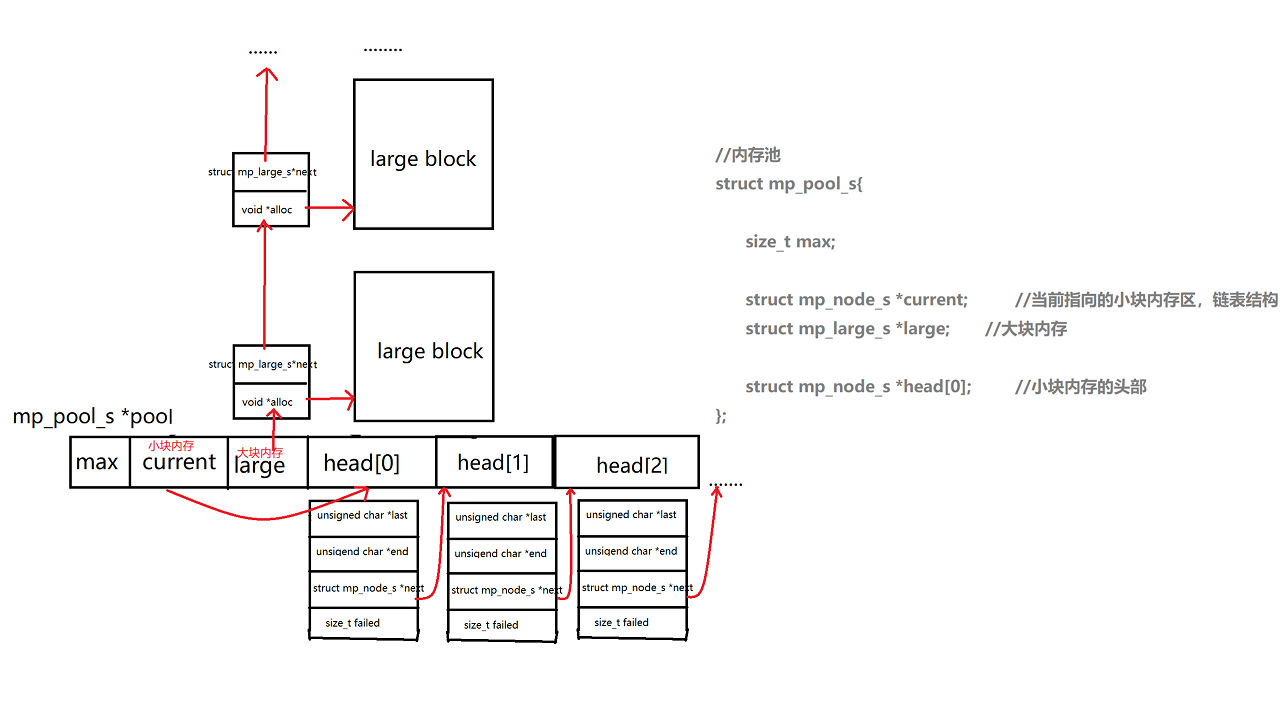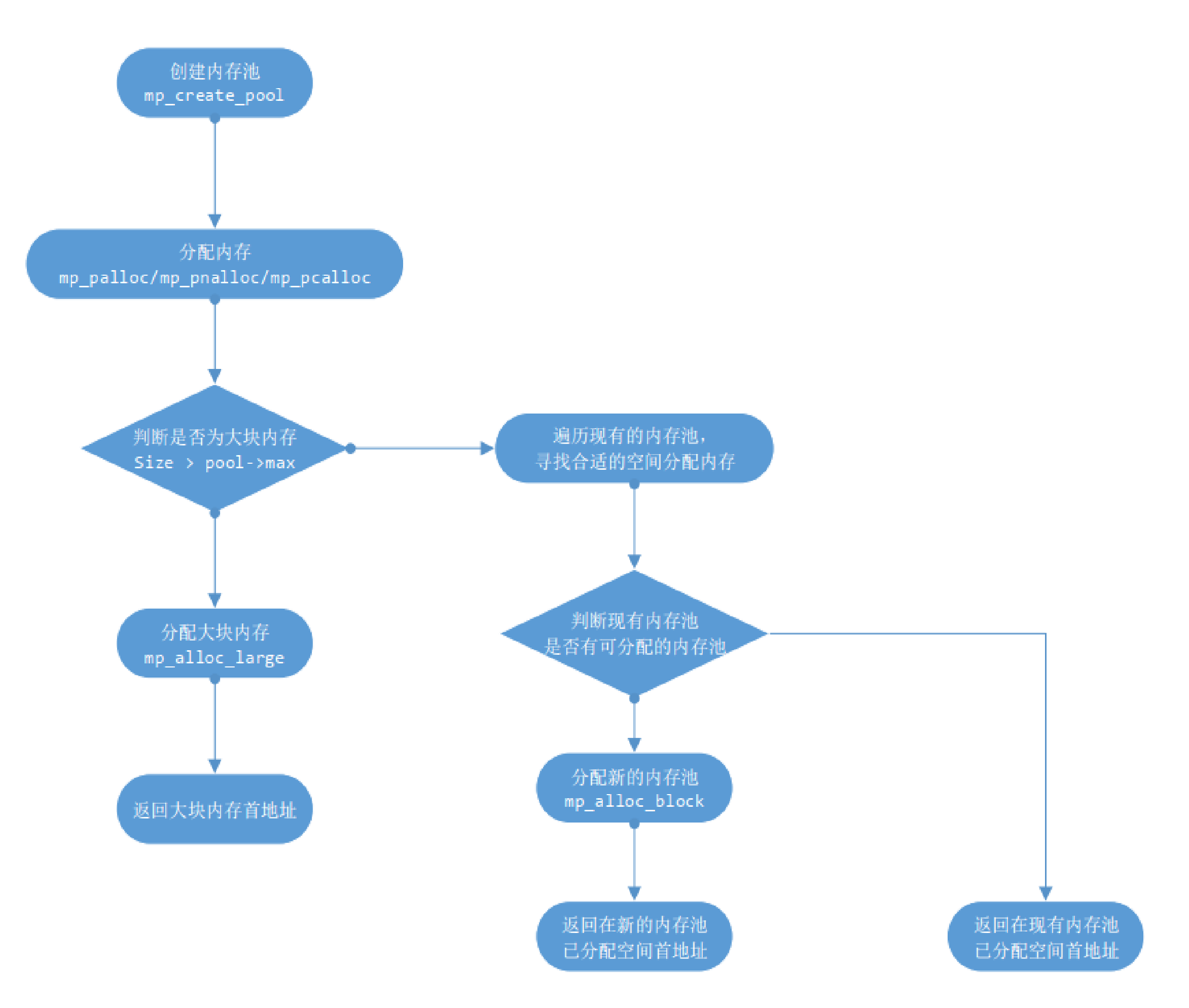The memory pool manages the heap
When a process executes, the operating system will allocate 0~4G of virtual memory space to the process. The parts that programmers can manage (allocate and release) are mmap mapping area and heap heap area, and the part managed by memory pool is the heap area of user process.
Why use a memory pool?
Memory pool is used to avoid heap fragmentation
- Avoid frequent allocation and release of memory (prevent fragmentation of heap area)
When the client connects to the server, the server will prepare part of the heap for message retention. When a connection is successful, the server will allocate a section of memory belonging to the connection in the heap. When the connection is closed, the allocated memory will be released. However, when the number of connections is large and too frequent, it is inevitable to allocate and release memory frequently. This will lead to small windows in the heap, that is, heap fragmentation.
What happens if the heap is fragmented?
- An undetectable BUG will appear after working for a long time
- Unable to allocate a large and whole block of memory, malloc returns NULL
Memory pool design
Scenario: how to implement a memory pool that can avoid memory fragmentation on a clean heap?
First: use linked list to manage memory
Use the linked list to connect the allocated pieces of memory in the heap area, set the flag (whether to be used) and let each segment of memory on the linked list node expand slowly.
What problems will occur when using the linked list alone?
- Memory blocks will be divided smaller and smaller, and the linked list will become longer and longer. You know you can't divide more memory.
So the idea of fixed memory is added to the design
When allocating a small segment of memory, the small segment of memory is divided fixedly, as shown below
- 16bytes
- 32bytes
- 64bytes
- 128bytes
- 256byts
- 512bytes
However, different fixed small memory allocations will cause the following problems:
- Find slow
- Find on assignment
- Find on release
- Gaps also occur between blocks
- Cannot merge blocks
- Small piece recycling trouble
Therefore, the memory pool model of custom fixed block and random block is finally obtained
Memory pool

Memory pool workflow

Memory pool structure
//Memory pool
struct mp_pool_s{
size_t max;
struct mp_node_s *current; //Small memory area currently pointed to, linked list structure
struct mp_large_s *large; //Block memory
struct mp_node_s *head[0]; //Header of small memory
};
Small pieces of memory are linked by a one-way linked list
//Small memory
struct mp_node_s{
unsigned char *last; //Current
unsigned char *end; //last
struct mp_node_s *next; //Next 4k
size_t failed;
};
Large blocks of memory are also linked with one-way linked lists
//Block memory
struct mp_large_s{
struct mp_large_s *next;
void *alloc;
};
API
Create memory pool
- Determine the size as the fixed size of the small memory
- First, last points to the first byte of the node
- end points to the last
//Create memory pool
struct mp_pool_s *mp_create_pool(int size){
struct mp_pool_s *pool;
int ret = posix_memalign((void**)&pool, ALIGNMENT, size + sizeof(struct mp_pool_s) + sizeof(struct mp_node_s));
if(ret)return NULL;
pool->max = (size<MP_MAX_ALLOC_FORM_POOL) ? size : MP_MAX_ALLOC_FORM_POOL;
pool->current = pool->head;
pool->head->last = (unsigned char*)pool + sizeof(struct mp_pool_s) + sizeof(struct mp_node_s);
pool->head->end = pool->head->last + size;
pool->head->failed = 0;
pool->large = NULL;
return pool;
}
Destroy memory pool
- First release a large block of memory and traverse the linked list
- Then release the small block and traverse the linked list
//Destroy memory pool
void mp_destroy_pool(struct mp_pool_s *pool){
struct mp_large_s *large;
for(large = pool->large; large!=NULL; large = large->next){ //Release block
if(large->alloc)free(large->alloc);
}
struct mp_node_s *h = pool->head->next;
while(h){ //Release small pieces
struct mp_pool_s *next = h->next;
free(h);
h = h->next;
}
free(pool);
}
Reset memory pool
- Free a large block of memory first
- Then point the last of the small memory to the first location of the memory
//Reset memory pool
void mp_reset_pool(struct mp_pool_s *pool){
struct mp_node_s *head;
struct mp_large_s *large;
for(large = pool->large; large; large=large->next){ //Large blocks will be released
if(large->alloc)free(large->alloc);
}
pool->large = NULL;
for(head = pool->head; head; head = head->next){ //Point the head position of each node to the position you just created
head->last = (unsigned char*)head + sizeof(struct mp_node_s);
}
}
Allocate a small block of memory to the memory pool
- First, allocate a whole block (size psize) of small memory, and create a node to point to this memory
- Memory alignment, using the tail insertion method to insert the last position of the linked list
- Readjust the current direction of the memory pool
/*Allocate a small memory block of psize size, and start pointing to the position head - > last = memblk + size, linked list tail interpolation method*/
static void *mp_alloc_block(struct mp_pool_s *pool, size_t size){
unsigned char *memblk;
struct mp_node_s *head = pool->head;
size_t psize = (size_t)(head->end - (unsigned char*)head); //psize = = parameter entered when creating memory pool
int ret = posix_memalign((void*)&memblk, ALIGNMENT, psize); //Allocate memory 24 byte alignment
if(ret)return NULL;
struct mp_node_s *p, *new_node, *current;
new_node = (struct mp_node_s*)memblk;
new_node->end = memblk + psize;
new_node->next = NULL;
new_node->failed = 0;
memblk += sizeof(struct mp_node_s); //Skip node structure for memory alignment
memblk = mp_align_ptr(memblk, ALIGNMENT); //memory alignment
new_node->last = memblk + size;
current = pool->current;
for(p = current; p->next; p = p->next){ //Tail interpolation
if(p->failed++>4)current = p->next;
}
p->next = new_node;
pool->current = current ? current : new_node;
return memblk;
}
Take out a memory of size from a small memory (no byte alignment)
- First, get the small block of memory pointed to by the current memory pool
- Follow the nodes one by one to find out whether there is enough memory allocation in the small memory
- If any, byte align the memory and return
- If there is no suitable block of memory, allocate an additional block of memory
- If the small memory allocation fails, the size is allocated by creating a large memory
//Take a block of size memory on a small memory area
void *mp_nalloc(struct mp_pool_s *pool, size_t size){
unsigned char *m;
struct mp_node_s *p;
if(size<=pool->max){
p = pool->current; //Current block point
do{
m = p->last;
if((size_t)(p->end - m)>=size){ //If the remaining memory of the current node is larger than size, it will be allocated in the node
p->last = m + size;
return m;
}
p = p->last;
//If the remaining size of no section is greater than size, reassign a block
}while(p);
return mp_alloc_block(pool, size);
}
//If the size exceeds the limit of small memory, it will be allocated in the way of large content allocation
return mp_alloc_large(pool, size);
}
Take out a block of size memory from a small block of memory (do byte alignment)
//In a small memory area, take a memory byte of size to align
void *mp_alloc(struct mp_pool_s *pool, size_t size){
unsigned char *memblk;
struct mp_pool_s *p;
if(size<=pool->max){
p = pool->current; //Current block point
do{
memblk = mp_align_ptr(p->last, ALIGNMENT);//Do byte alignment
if((size_t)(p->end-memblk) >= size){ //If the remaining memory of the current node is larger than size, it will be allocated in the node
p->last = memblk + size;
return memblk;
}
p = p->next;
}while(p);
//If the remaining size of no section is greater than size, reassign a block
return mp_alloc_block(pool, size);
}
//If the size exceeds the limit of small memory, it will be allocated in the way of large content allocation
return mp_alloc_large(pool, size);
}
Take out a memory of size from a small memory and initialize it to 0
//Allocate memory and initialize to 0
void *mp_calloc(struct mp_pool_s *pool, size_t size){
void *p = mp_alloc(pool, size);
if(p){
memset(p, 0 , size);
}
return p;
}
Allocate large memory of size (nodes of large memory are placed in small memory)
- First, malloc gets the first address of the memory, and then hangs the large memory on the memory pool. If the structure of the large memory is not created, it is created in the small memory
- After creation, hook up and return the first address of large memory
//Create large blocks of memory
static void *mp_alloc_large(struct mp_pool_s *pool, size_t size){
void *p = malloc(size); //distribution
if(p==NULL)return NULL;
size_t n = 0;
struct mp_large_s *large;
for(large=pool->large; large; large = large->next){
if(large->alloc == NULL){
large->alloc = p;
return p;
}
if(n++>3)break;
}
//Large memory cannot be connected
large = mp_alloc(pool, sizeof(struct mp_large_s));
if(large==NULL){
free(large);
return NULL;
}
large->alloc = p;
large->next = pool->large;
pool->large = large;
return p;
}
Frees a specified chunk of memory p
- Find before release
//Free memory p
void mp_free(struct mp_pool_s *pool, void *p){
struct mp_large_s * large;
for(large = pool->large; large; large = large->next){
if(p==large->alloc){
free(large->alloc);
large->alloc = NULL;
return;
}
}
Overload posix_memalign
//Reconfiguration mem_memalign
void *mp_memalign(struct mp_pool_s *pool, size_t size, size_t alignment){
void *p;
int ret = posix_memalign(&p, alignment, size);
if(ret){
return NULL;
}
struct mp_large_s *large = mp_alloc(pool, sizeof(struct mp_large_s ));
if(ret)return NULL;
struct mp_large_s *large = mp_alloc(pool, sizeof(struct mp_large_s));
if(large==NULL){
free(p);
return NULL;
}
large->alloc = p;
large->next = pool->large;
pool->large = large;
return p;
}
Memory alignment formula
#define MP_ALIGNMENT 32 #define MP_PAGE_SIZE 4096 #define MP_MAX_ALLOC_FROM_POOL (MP_PAGE_SIZE-1) #define mp_align(n, alignment) (((n)+(alignment-1)) & ~(alignment-1)) #define mp_align_ptr(p, alignment) (void *)((((size_t)p)+(alignment-1)) & ~(alignment-1))